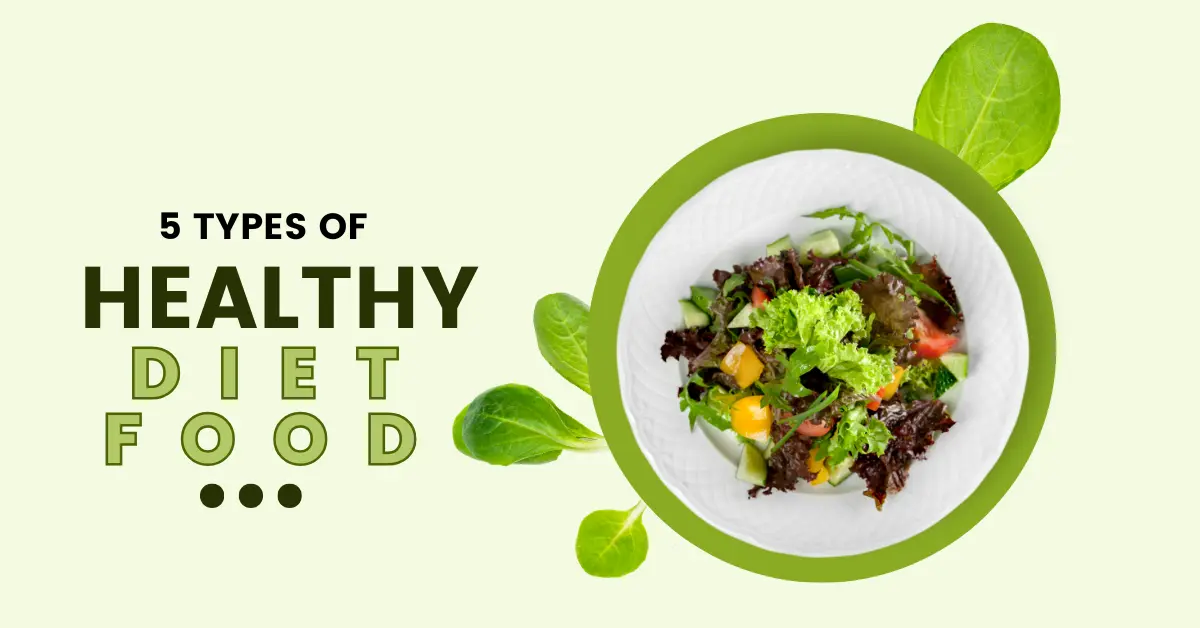
A healthy diet is essential for a strong and active life. Eating nutritious foods, like fruits, vegetables, whole grains, and lean proteins, provides your body with the vitamins, minerals, and energy it needs to function well. A balanced diet helps maintain a healthy weight, improves digestion, boosts your immune system, and lowers the risk of chronic diseases like diabetes and heart issues. It also improves mood, concentration, and overall well-being. Simply put, eating healthy is a key step towards a happier, healthier, and more energetic life every day.
5 Types of Healthy Diet Food
Eating well is important for our health. A good diet can help us feel better and stay strong. But with so many food choices, it can be hard to know what to eat. Let’s look at five types of healthy diet foods that can be part of a good diet. We’ll also see how these fit into Indian cooking.
Colorful Fruits and Vegetables
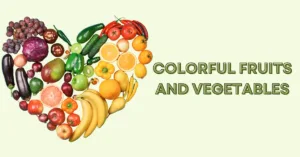
Fruits and vegetables are full of good things our bodies need. They have vitamins, minerals, and fiber. These help our bodies work well and fight off sickness. Eating different colors of fruits and vegetables gives us different health benefits.
Some healthy Indian fruits:
- Mangoes: Sweet and tasty, full of vitamin C
- Guavas: Rich in vitamin C and fiber
- Pomegranates: Have antioxidants that are good for our hearts
- Papayas: Good for digestion and have lots of vitamins
Some healthy Indian vegetables:
- Spinach (palak): Full of iron and good for our blood
- Bitter gourd (karela): Helps control blood sugar
- Bottle gourd (lauki): Easy to digest and good for weight loss
- Okra (bhindi): Has fiber and helps with digestion
Try to eat fruits and vegetables of all colors. Each color gives us different healthy things. For example, orange foods like carrots are good for our eyes. Green foods like spinach help our blood stay healthy.
In Indian cooking, you can add vegetables to dal or make mixed vegetable curries. Fruits can be eaten as snacks or made into fresh juices.
Whole Grains

Whole grains are foods that use all parts of the grain. They have more nutrients and fiber than foods made with white flour. Fiber helps us feel full and keeps our stomachs happy.
Some healthy Indian whole grains:
- Brown rice: Has more fiber than white rice
- Whole wheat (atta): Used to make rotis and chapatis
- Jowar (sorghum): Good for people who can’t eat wheat
- Bajra (pearl millet): Gives us energy and helps with digestion
- Ragi (finger millet): Has lots of calcium, good for bones
These grains can be used in many Indian dishes. You can make rotis with whole wheat flour or jowar flour. Brown rice can be used instead of white rice in pulao or biryani. Ragi can be made into dosa or porridge.
Whole grains take longer for our bodies to break down. This means they give us energy slowly over time, which is good for keeping our blood sugar steady.
Lean Proteins
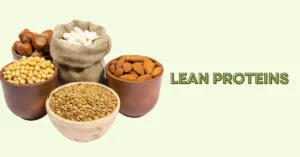
Proteins are important for building and fixing our body parts. They also help us feel full. Lean proteins are types of protein foods that don’t have much fat.
Some healthy Indian protein sources:
- Lentils (dal): Many types like moong, masoor, toor
- Chickpeas (chana): Used in dishes like chana masala
- Tofu: Made from soybeans, can be used in curries
- Fish: Especially fish like salmon, rich in good fats
- Chicken breast: Low in fat, can be used in many dishes
- Eggs: Can be boiled, made into curry, or used in other dishes
In Indian cooking, lentils and chickpeas are often used in dal and curries. These are good for vegetarians to get protein. For those who eat meat, grilled or roasted chicken and fish are healthy choices.
Proteins are important for everyone, but especially for people who exercise a lot or are trying to build muscle.
Healthy Fats
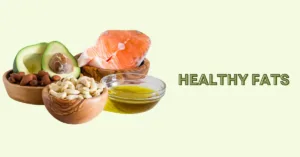
Not all fats are bad for us. Some fats are good and help our bodies work well. These good fats can help our hearts and brains stay healthy.
Some sources of healthy fats in Indian foods:
- Nuts: Almonds, walnuts, and peanuts
- Seeds: Pumpkin seeds, sunflower seeds, and flax seeds
- Avocado: Can be added to salads or made into chutney
- Olive oil: Good for cooking or in salad dressings
- Fish: Extremely fatty fish like salmon or mackerel
- Coconut: Used in many South Indian dishes
In Indian cooking, you can add nuts to your breakfast porridge or use them in desserts. Seeds can be sprinkled on salads or added to roti dough. Coconut is often used in curries, especially in South Indian cooking.
While these fats are good for us, we should still eat them in small amounts. A tiny bit goes a long way in keeping us healthful.
Fermented Foods
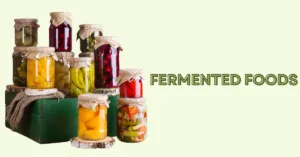
Fermented foods are foods that have been changed by tiny living things called good bacteria. These foods are good for our stomachs and help us digest other foods better.
Some healthy Indian fermented foods:
- Yogurt (dahi): Used in raita, lassi, or eaten plain
- Idli: A South Indian food made from fermented rice and lentils
- Dosa: Another South Indian food, a thin pancake made from a fermented batter
- Dhokla: A Gujarati snack created from fermented chickpea flour
- Kanji: A drink made from fermented carrots or beetroot
These foods not only taste good but also help keep the good bacteria in our stomachs happy. This can help our overall health.
In Indian meals, you can add a small bowl of yogurt or raita to your lunch or dinner. Idli and dosa make good breakfast or snack options.
How to Have These Nutrition in Your Diet
Now that we know about these healthy foods, how can we eat them every day? Here are some tips:
- Start with small differences: Don’t try to switch everything at once. Maybe start by adding one new vegetable to your meals each week.
- Make colorful plates: Try to have different colored fruits and vegetables in your meals. This makes your food look nice and gives you different nutrients.
- Switch to whole grains: If you usually eat white rice, try brown rice sometimes. Or use whole wheat flour for your rotis.
- Add protein to every meal: Whether it’s dal, eggs, or chicken, try to have some protein in each meal. This permits you to feel full for longer.
- Snack on nuts and fruits: Instead of chips or sweets, try having a handful of nuts or a piece of fruit as a snack.
- Try new recipes: Look for healthy recipes that use these foods. You might find new dishes you like.
- Plan your meals: Thinking ahead about what you’ll eat can help you include more healthy foods.
- Drink water: While not a food, drinking enough water is important for health. Attempt to drink water throughout the day.
Remember, eating healthy doesn’t mean you can never eat your favorite treats. It’s about eating good food most of the time. You can still enjoy special foods on occasion.
Also, everyone’s body is different. What functions for one individual might not perform for another? If you have any health problems or concerns, it’s a good idea to talk to a doctor or a nutrition expert before making big changes to what you eat.
Conclusion
Eating well is one part of staying healthy. Along with good food, try to be active every day. This could be going for a walk, doing yoga, or any activity you enjoy. Getting enough sleep is also important for health.
In the end, a healthy diet is about balance. Try to include different types of good foods in your meals. Over time, eating well can become a habit. You might find that you feel better and have more energy when you eat these healthy foods regularly.
Start with small steps and keep going. Every healthy choice you make is good for your body. Enjoy trying new foods and finding tasty ways to eat well.
FAQs
What makes a diet healthy?
A healthy diet includes a mix of fruits, vegetables, whole grains, and lean proteins. It’s about eating balanced meals, staying hydrated, and avoiding too much sugar, salt, and processed foods.
How can I start eating healthier?
Start by adding more fruits, vegetables, and whole grains to your daily meals. Replace sugary drinks with water, and choose lean proteins. Making small, gradual changes will make it easier to stick to healthier eating.
Why are fruits and vegetables essential in a nutritious diet?
Fruits and vegetables provide essential vitamins, minerals, and fiber that keep your body strong and functioning well. They also help lower the risk of many diseases, supporting overall health and well-being.
How much water should I drink daily?
Aim for about 8 cups (2 liters) of water daily, but individual needs may vary. Drinking enough water helps digestion, boosts energy, and keeps your skin and body healthy.
Can I still enjoy my favorite treats on a healthy diet?
Yes, moderation is key! You can occasionally enjoy your favorite treats. Just balance them with healthy meals and snacks, and don’t overindulge. A healthy diet food is about balance, not limitation.
Also Read:
7 Simple, Sustainable Nutrition Tips for Long-Term Health
7 Healthy Diet Plans to Improve Your Wellbeing
References:
https://simple.m.wikipedia.org/wiki/Healthy_diet
Disclaimer:
The information in this blog is for informational purposes only and should not replace professional medical advice. Always consult a healthcare provider or dietitian before making changes to your diet. Individual needs may vary, and results are not guaranteed for everyone.
Related post

7 Health Benefits of Assam Tea


